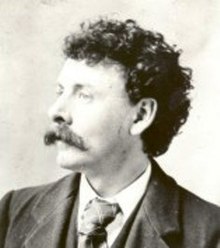George Albert Smith (film pioneer)
| George Albert Smith | |
|---|---|

George Albert Smith around 1900
|
|
| Born |
4 January 1864 London, England |
| Died | 17 May 1959 (aged 95) Brighton, Sussex, England |
| Occupation | Film maker, inventor |
George Albert Smith (4 January 1864 – 17 May 1959) was an English stage hypnotist, psychic, magic lantern lecturer, Fellow of the Royal Astronomical Society, inventor and a key member of the loose association of early film pioneers dubbed the Brighton School by French film historian Georges Sadoul. He is best known for his controversial work with Edmund Gurney at the Society for Psychical Research, his short films from 1897 to 1903, which pioneered film editing and close-ups, and his development of the first successful colour film process, Kinemacolor.
Smith was born in Cripplegate, London in 1864. His father Charles Smith was a ticket-writer and artist. He moved with his family to Brighton, where his mother ran a boarding house on Grand Parade, following the death of his father.
It was in Brighton in the early 1880s that Smith first came to public attention touring the city's performance halls as a stage hypnotist. In 1882 he teamed up with Douglas Blackburn in an act at the Brighton Aquarium involving muscle reading, in which the blindfolded performer identifies objects selected by the audience, and second sight, in which the blindfolded performer finds objects hidden by his assistant somewhere in the theatre.
The Society for Psychical Research (SPR) accepted Smith's claims that the act was genuine and after becoming a member of the society he was appointed private secretary to the Honorary Secretary Edmund Gurney from 1883 to 1888. In 1887, Gurney carried out a number of "hypnotic experiments" in Brighton, with Smith as his "hypnotiser", which in their day made Gurney an impressive figure to the British public.
...
Wikipedia
